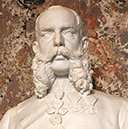0262 Die Inszenierung der vier österreichischen Kaiser im Langen 19. Jahrhundert in der Porträtbüste
Identifiers (Article)
Abstract
Portrait busts became a particularly popular form of representation in the nineteenth century. Even among the Habsburgs, sculpted portraits superseded portrait painting, which had been so popular with them in the past. From the founding of the Austrian Empire in 1804 to the end of the monarchy in 1918, all Habsburg monarchs had themselves portrayed in this increasingly important medium. The essay outlines which artistic options were chosen in each case. For both artists and patrons had to adapt to frequently changing political, social, and economic situations as well as stylistic changes in the nineteenth century.
Statistics


Published (Versions)
- 2021-07-10 (2)
- 2021-07-10 (1)
License

This work is licensed under a Creative Commons Attribution-NonCommercial-NoDerivatives 4.0 International License.



